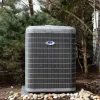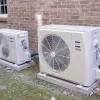As the temperatures around Atlanta climb and summer unleashes its sweltering fury, we need our air conditioners to work. And while our primary request is that the AC cools our home effectively, we also want it to use the least amount of energy possible.
In short, we want our air conditioner to be efficient.
Luckily, there’s a way to measure air conditioner efficiency. It’s a number, and it’s called the seasonal energy efficiency ratio (aka, SEER). Every AC has one. The higher the number, the more efficient the air conditioner. Seems simple enough, right?
Unfortunately, it isn’t.
An AC’s SEER rating is just an average.
Every central air conditioner is available for purchase rates at 14 to 26 SEER. Those numbers are for traditional ducted systems. Mini-split systems may rate even higher.
Generally speaking, a higher SEER indicates a more efficient air conditioner. However, there are different variables involved that could make a given AC less or more efficient than another one despite its SEER rating.
One of those variables is a season. You see, there’s another rating that you can use to measure the efficiency of an air conditioner: EER. It’s the “energy efficiency ratio,” which, in case you haven’t guessed, is the same thing as SEER, minus the “seasonal” qualifier.
An AC’s EER can be calculated at any given moment using the AC’s current BTUh of output and its watts of energy input. SEER, on the other hand, is the average of an AC’s EER across an entire season. SEER, unlike EER, accounts for seasonal variations, even though your AC’s actual operational efficiency in late April may be very different from what it is in the middle of July!
Just keep in mind that an AC rated at, say, 19 SEER won’t always perform at 19 EER every time it runs. It may operate less efficiently under tougher conditions (e.g., a really hot day in July or August).
High-SEER air conditioners aren’t always the most efficient air conditioners.
If you’re dead set on getting an efficient AC, SEER is just one factor to consider. The other major consideration – and it’s arguably even more important than SEER – is whether the AC is a standard or a variable speed model.
Sometimes, variable-speed air conditioners will have the same SEER rating as standard models, even when they consume less energy in real-world conditions!
You probably own a standard air conditioner today. It turns on and off according to your thermostat setting. Set your thermostat to 74, and the AC runs until the indoor temperature is 74. Then it turns off.
A standard AC only has one fan speed, and it’s a high speed. It runs at full blast every time it cuts on. Either the AC is pummeling you with cool air or it isn’t running at all. There’s no “in-between” setting.
Variable-speed air conditioners work differently. Depending on the conditions in the home, they’ll run at either a low or a high speed at any given moment. Most of the time, they’ll only run at a low speed. That’s because when your thermostat is set to 74 (or whatever temperature you like), the AC can keep the home perpetually cool without ramping up to a high speed.
Typically, variable-speed air conditioners only run at a high speed on super-hot days or when you set the thermostat to a much lower temperature than the current ambient temperature (like when it’s 77 degrees in your house and you set the thermostat to 68).
So, why does all of that matter for AC efficiency? Well, air conditioners use lots of energy when they:
- Turn on to begin a cooling cycle
- Run at a really powerful speed/li>
Unlike standard air conditioners, variable speed systems don’t turn on and off very often. They have long cooling cycles and can run at a low speed for most of the entire day! As such, they avoid both of the most energy consumptive aspects of AC usage.
That’s not always factored into SEER, though. It’s possible for a standard AC and a variable speed AC to both be rated at 18 SEER. But the variable speed system will be vastly more efficient in real-world operating conditions!
Note: There are also two-speed air conditioners. These systems have a high speed and a low speed. They operate at low speed most of the time. Two-speed systems are more efficient than standard systems, but nowhere near as efficient as variable-speed systems.
Now that you know what a SEER rating is, does it seem so important?
SEER is important, but it’s not the only thing that matters for AC efficiency. Think of it as one valuable guidepost among other valuable guideposts.
Standard vs. variable speed matters a lot. The quality of your AC installation also matters. So does the design of your duct system and the quality of your ducts. To some extent, even the brand of AC makes a difference!
If you’re evaluating air conditioners and want to choose an efficient model, just be sure you’re looking beyond SEER and considering the other factors that impact an AC’s efficiency.






